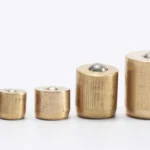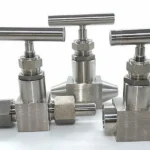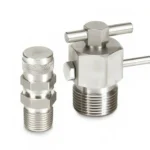En muchos sistemas de válvulas industriales, los ingenieros de mantenimiento se enfrentan a menudo a un problema recurrente: la presión residual atrapada en el interior de la cavidad de la válvula incluso después del cierre. Esta presión oculta puede provocar graves riesgos para la seguridad y costosos tiempos de inactividad si no se purga adecuadamente. Para solucionarlo, los ingenieros utilizan un componente especializado conocido como bonete de purgadiseñado para liberar de forma segura la presión atrapada y garantizar un mantenimiento fiable de la válvula.
Un bonete de purga es un componente de retención de presión instalado en un conjunto de válvulas que proporciona una vía de ventilación segura para la presión atrapada en el interior del cuerpo o cavidad de la válvula. Permite al personal de mantenimiento liberar manualmente el fluido o gas residual de la cámara de la válvula antes del desmontaje o la inspección, lo que reduce el riesgo de pulverización accidental, daños en el equipo o lesiones del operario en sistemas de alta presión.
Entender cómo funciona un bonete de purga -y por qué es fundamental- puede mejorar significativamente la seguridad, el rendimiento y la fiabilidad de los conjuntos de válvulas utilizados en aplicaciones industriales, petroquímicas y energéticas.
¿Cuál es la función de un bonete de purga en un conjunto de válvulas?
Un bonete de purga sirve tanto para retener la presión como para liberarla. Estructuralmente, funciona como un bonete tradicional -sellando la parte superior del cuerpo de la válvula y soportando el vástago-, pero añade una función de ventilación integrada que permite liberar de forma controlada los medios atrapados en el interior de la cámara de la válvula.

Cuando una válvula, como una Doble bloqueo y sangrado (DBB) o válvula de bola de instrumentaciónCuando se cierra la válvula de bloqueo, pueden quedar pequeñas bolsas de presión entre las válvulas de bloqueo o dentro de la cavidad de la válvula. Sin un mecanismo de ventilación, esta presión atrapada puede hacer que el mantenimiento sea peligroso o incluso imposible. El bonete de purga resuelve este problema proporcionando un puerto de purga (a menudo roscado con conexiones ¼″ o ½″ NPT) que los operarios pueden abrir para purgar la presión de forma segura.
¿Por qué es importante un bonete de purga en los sistemas de válvulas de alta presión?
La presión residual es uno de los peligros más subestimados en los sistemas de control de fluidos. Incluso unos pocos bares de presión atrapada pueden expulsar juntas, empaquetaduras o tapones cuando se abre una válvula para su mantenimiento. En industrias como petróleo y gas, procesamiento químico, generación de energía e instrumentacióncuando las presiones del sistema pueden superar los 10 000 psi (≈690 bar), la ventilación no es opcional, sino una necesidad.

Sin un bonete de purga, los operarios a menudo tienen que aflojar racores o retirar pequeños tapones para liberar la presión, lo que resulta arriesgado y lleva mucho tiempo. Un bonete de purga correctamente diseñado integra la ruta de purga directamente en el conjunto del bonete, lo que permite a los técnicos verificar que la presión se ha descargado de forma segura antes de iniciar cualquier trabajo de desmontaje.
Este pequeño detalle de diseño aumenta enormemente la seguridad del sistema, simplifica el mantenimiento y garantiza el cumplimiento de normas operativas como API 6D, ASME B16.34y ISO 15848.
¿Cómo funciona un bonete de purga?
El principio de funcionamiento de un bonete de purga es sencillo pero muy eficaz.

Válvula de cierre - La válvula aísla el fluido o el gas cerrando las válvulas de bloqueo aguas arriba y aguas abajo.
Formación de presión residual - El fluido atrapado entre las válvulas de bloqueo o dentro de la cavidad conserva la presión.
Operación de sangrado - El operario abre el orificio de purga del capó con una llave inglesa o una manivela.
Ventilación controlada - La presión atrapada escapa de forma segura a través del canal de purga a la atmósfera o a una línea de drenaje.
Verificación - Una vez que no sale fluido ni gas por el puerto, se confirma que la presión es cero y se puede proceder al mantenimiento.
Algunos capós de purga avanzados incorporan características como un comprobar enchufe, puerto de engraseo orificio de ventilación secundario para una doble seguridad. Otros están equipados con tapas con resorte o racores rápidos para un funcionamiento rápido y sin fugas.
¿Cuál es la diferencia entre un bonete de válvula y un bonete de purga?
A bonete de válvula estándar cierra y sella la parte superior del cuerpo de una válvula, soportando el vástago, la empaquetadura y otras partes móviles. Su función principal es la integridad mecánica: mantiene la presión y conecta el actuador con el embellecedor interno de la válvula.
A bonete de purgapor otro lado, amplía este diseño incorporando un puerto o tapón de ventilación externo. Esta vía adicional permite a los operarios descargar de forma segura cualquier medio residual que quede tras el cierre de la válvula.
| Característica | Capó estándar | Tapón de purga |
| Función principal | Contención de la presión y soporte del vástago | Contención de la presión y liberación de presión |
| Ruta de ventilación | Ninguno | Puerto de purga integrado (manual o tapón roscado) |
| Nivel de seguridad | Básico | Mejorado: ventilación segura antes del mantenimiento |
| Uso típico | Válvulas de aislamiento generales | Válvulas de doble bloqueo y purga, instrumentación de alta presión |
| Mantenimiento | Debe retirar el capó para liberar la presión | Presión liberada a través del puerto antes de la extracción |
Así pues, el bonete de purga es una evolución mejorada de la seguridad del bonete de válvula convencional, especialmente vital en aplicaciones de instrumentación y alta presión.
¿Cuáles son los principales componentes de un bonete de purga?
Un capó de purga típico consta de:

Cuerpo del capó: Carcasa de acero inoxidable forjado (316/316L) o de acero al carbono que se fija al cuerpo de la válvula.
Puerto de ventilación: conexión roscada, normalmente ¼″ o ½″ NPT/BSP, provista de un tapón o tornillo.
Elementos de sellado: Juntas tóricas, PTFE o sellado metal-metal para evitar fugas.
Vástago y empaquetadura: admite funcionamiento manual o accionado por actuador.
Accesorios opcionales: tapones de comprobación, puertos de prueba o puertos de engrase para una mayor funcionalidad.
Los materiales de alta calidad son esenciales porque los casquillos de purga suelen soportar presiones, temperaturas y entornos corrosivos extremos. Por ejemplo, el acero inoxidable 316L ofrece una excelente resistencia a la corrosión para aplicaciones químicas y en alta mar, mientras que el acero inoxidable 316L ofrece una excelente resistencia a la corrosión para aplicaciones químicas y en alta mar. Inconel 625 o Monel pueden resistir altas temperaturas o ambientes con gases ácidos.
¿En qué aplicaciones se utilizan las boinas de purga?
Los bonete de purga son indispensables en sistemas en los que es obligatorio verificar la presión cero antes del mantenimiento. Entre las industrias y aplicaciones más comunes se incluyen:

1. Industria del petróleo y el gas
Utilizado en equipos de cabeza de pozo, sistemas colectoresy válvulas de doble bloqueo y purga para purgar los hidrocarburos atrapados de forma segura antes del mantenimiento. En las operaciones upstream y midstream, esto minimiza el riesgo de reventones o escapes de gas.
2. Plantas químicas y petroquímicas
En sistemas de fluidos corrosivos o reactores de alta presión, los capós de purga permiten una despresurización segura y evitan la proyección de productos químicos durante el desmontaje.
3. Generación de energía y sistemas de vapor
Ayudan a liberar la presión del vapor o condensado en sistemas de turbinas o circuitos de agua de alimentación a alta temperatura, evitando quemaduras y mejorando la seguridad de los trabajadores.
4. Instrumentación y control de procesos
Los capós de purga son comunes en colectores de instrumentación y válvulas dosificadoras calibrar los instrumentos de forma segura purgando las líneas de proceso antes de sustituir el sensor.
5. Sistemas hidráulicos y neumáticos
En equipos pesados o paneles de control de procesos, el bonete de purga garantiza una liberación segura de la presión antes de cambiar racores, manómetros o juntas.
Cómo elegir el purgador adecuado
La selección del bonete de purga adecuado implica varias consideraciones de ingeniería:
Presión nominal - Iguale o supere la presión máxima de trabajo de la válvula. Los capós de purga de Walter Valves pueden alcanzar presiones nominales de hasta 10 000 psi (≈690 bar).
Compatibilidad de materiales - Elija materiales compatibles con el medio y el entorno. Para fluidos corrosivos, utilice SS 316L o Inconel; para sistemas sensibles a los costes, acero al carbono con revestimiento de zinc.

Temperatura - Verificar que los materiales de las juntas soportan las temperaturas extremas previstas (-50 °C a +232 °C o más).
Tipo de conexión - Asegúrese de que la rosca y el sellado del orificio de ventilación coincidan con su sistema existente (NPT, BSP o roscas personalizadas).
Conformidad - Compruebe las normas pertinentes (API 6D, ASME B16.34, ISO 9001).
Acceso para mantenimiento - Asegúrese de que los operarios pueden acceder fácilmente al puerto de purga y conectar el tubo de drenaje.
Certificaciones y pruebas - Exigir informes de presión, fugas y trazabilidad de materiales para garantizar la calidad.
Con estos criterios, puede especificar con confianza un bonete de purga adecuado para los requisitos de rendimiento y seguridad de su conjunto de válvulas.
Errores comunes al utilizar o especificar capós de purga
Incluso los ingenieros más experimentados pasan por alto detalles cruciales. Evite estas trampas:
- Ignorar la compatibilidad de la presión: Si se instala un bonete de purga de baja capacidad en un sistema de alta presión, se corre el riesgo de que se produzca un fallo catastrófico.
- Selección incorrecta del material: Los materiales no compatibles pueden provocar corrosión galvánica o fragilización.
- Mal enrutamiento de ventilación: La ventilación directa hacia el personal o los equipos no es segura; utilice siempre una vía de descarga segura.
- Falta de mantenimiento: Las juntas tóricas o los sellos de los orificios de purga se degradan con el tiempo; inspecciónelos regularmente.
- Incumplimiento: Garantizar que todos los componentes cumplen las normas de seguridad locales e internacionales.
Evitar estos errores garantiza un funcionamiento más seguro y prolonga la vida útil tanto de la válvula como del bonete.
¿Cuáles son las ventajas de utilizar un bonete de purga?
| Beneficio | Descripción |
| Seguridad | Evita la liberación repentina de presión durante el mantenimiento; reduce el riesgo de lesiones. |
| Eficiencia operativa | Permite un venteo rápido sin desmontaje, lo que minimiza el tiempo de inactividad. |
| Reducción de costes | Evita daños en juntas y componentes, reduciendo los costes de sustitución. |
| Cumplimiento de la normativa | Cumple los requisitos de seguridad de las normas sobre petróleo y gas, productos químicos e instrumentación. |
| Facilidad de mantenimiento | Simplifica los procedimientos de despresurización e inspección. |
| Versatilidad | Compatible con múltiples tipos de válvulas: válvulas de bola, válvulas de aguja, colectores, conjuntos DBB. |
¿Por qué elegir los casquillos de purga de Walter Valves?
En Walter ValvesEstamos especializados en válvulas y accesorios de precisión para instrumentación, incluidos los casquillos de purga. Nuestra empresa cuenta con una planta de procesamiento de 3 000 m² en China y atiende a clientes de Oriente Medio, el Sudeste Asiático, Europa, Estados Unidos, Japón y Corea del Sur.

Nuestras principales ventajas son:
- Precios directos de fábrica: Precios de fábrica competitivos sin intermediarios.
- Amplio inventario: Un stock listo garantiza una entrega rápida.
- Capacidad de personalización: Material, tamaño y tipos de conexión adaptados a las especificaciones del cliente.
- Amplia gama de productos: Válvulas de bola para instrumentación, válvulas de aguja, válvulas antirretorno, válvulas dosificadoras, distribuidores, válvulas de doble bloqueo y purga, racores de engrase, racores antirretorno, tapones de cavidad, válvulas de alivio y casquillos de purga.
- Control de calidad: Cada producto se prueba para garantizar la integridad de la presión, la resistencia a las fugas y la precisión dimensional.
Estos puntos fuertes hacen de Walter Valves un proveedor de confianza para fabricantes de equipos originales, contratistas EPC y compradores industriales de todo el mundo.
¿Cómo mejora un bonete de purga los sistemas de válvulas de doble bloqueo y purga?
En Doble bloqueo y sangrado (DBB) configuraciones, dos válvulas de bloqueo aíslan el flujo aguas arriba y aguas abajo, mientras que una válvula de purga o bonete de purga conecta la cavidad entre ellas.
He aquí por qué esta integración es tan crucial:
En el bonete de purga confirma la integridad de la válvula: cuando se abre, la ausencia de descarga de presión indica un sellado correcto.
En simplifica el drenaje y enjuague de la cavidadmejorar la limpieza del proceso.
En permite el mantenimiento sin interrumpir la tuberíareduciendo el tiempo de inactividad.
En mejora la fiabilidad del sistemapor lo que es vital para equipos de proceso de alto valor en refinerías, plantas de GNL y sistemas de control hidráulico.
Por tanto, el capó de purga no es un mero accesorio, sino un elemento de seguridad fundamental para los sistemas DBB.
Consejos de mantenimiento e inspección de los capós de purga
Para garantizar el rendimiento a largo plazo:
Inspeccionar antes de cada ciclo de mantenimiento en busca de corrosión, fugas o residuos.
Lubricar las roscas en el tapón de purga para evitar el gripado.
Sustituir elementos de estanqueidad periódicamente, sobre todo en caso de exposición a productos químicos agresivos.
Confirmar presión cero antes de desatornillar el capó o el cuerpo de la válvula.
Etiquetar el conducto de ventilación para mayor claridad en sistemas de tuberías complejos.
Seguir estas prácticas prolonga la vida útil y garantiza una fiabilidad constante de la ventilación.
Conclusión
A bonete de purga es un componente crítico, aunque a menudo pasado por alto, de los conjuntos de válvulas, que garantiza la despresurización segura de los fluidos o gases atrapados antes del mantenimiento. Mejora la seguridad operativa, evita costosos accidentes y simplifica la inspección en una amplia gama de sistemas industriales.
Tanto si gestiona tuberías de alta presión, reactores químicos o colectores de instrumentación, especificar el bonete de purga adecuado significa proteger tanto sus equipos como a su personal.
En Válvulas Waltercombinamos precios de fábrica, inventario suficientey corto plazo de entrega con la experiencia necesaria para personalizar los capós de purga para su aplicación exacta. Para obtener especificaciones detalladas o peticiones de oferta, póngase en contacto con nosotros en info@waltervalvmailto:kesen@hxnewmaterial.comes.es - nuestro equipo está preparado para ayudarle en su próximo proyecto de válvulas.




